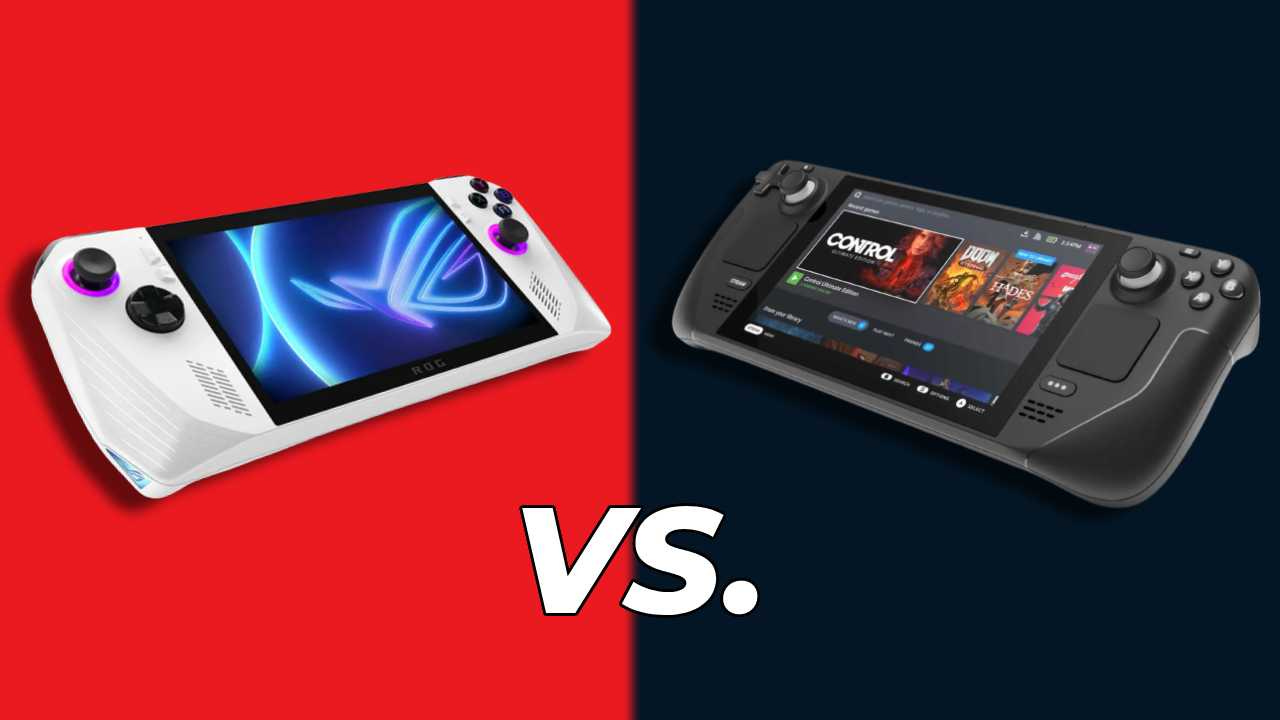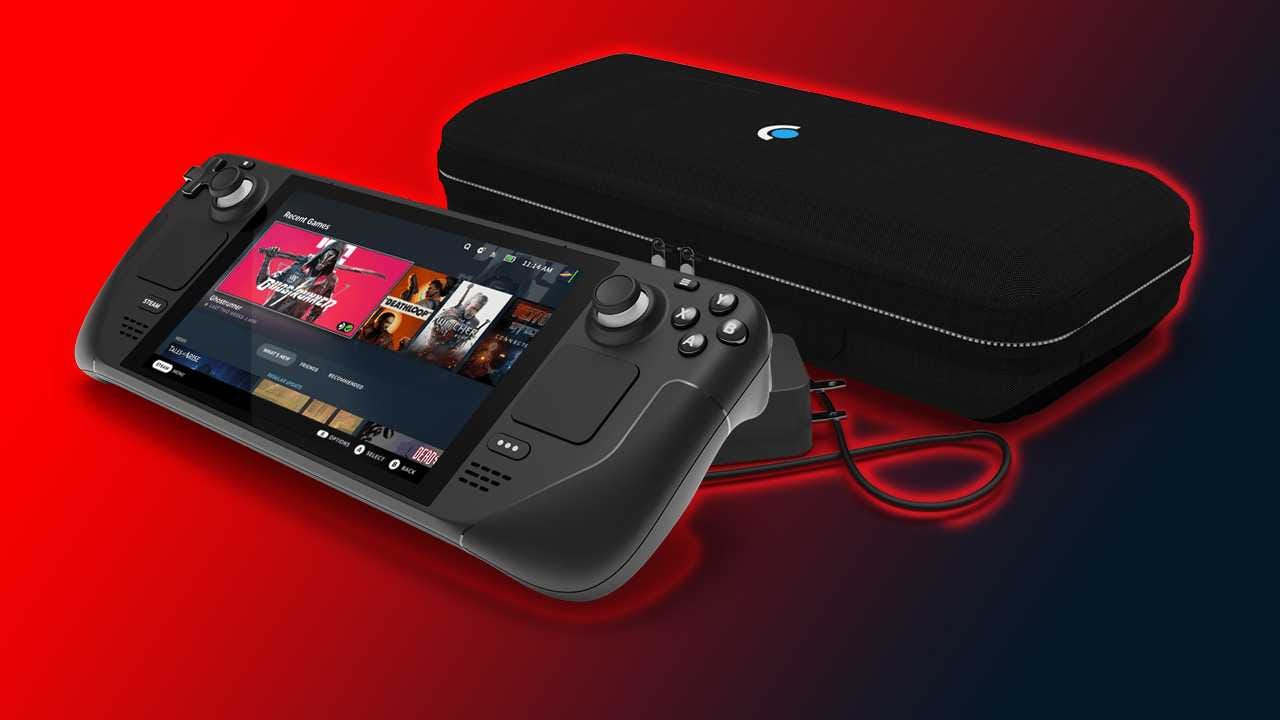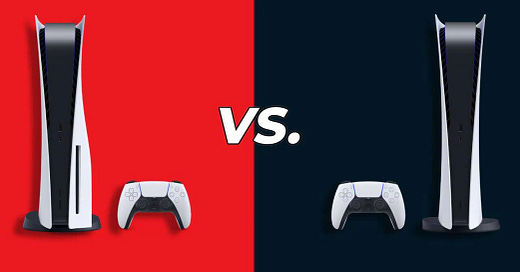
Asus ROG Ally vs Steam Deck: which portable gaming PC comes out on top?
The Steam Deck has some stiff competition from the Asus ROG Ally, but which one is right for you?
The battle to be the best portable gaming PC is now in full swing, as we put the Asus ROG Ally and Valve’s Steam Deck head to head to see which one is the king of portable PCs.
Both handhelds have their strengths and weaknesses, but when it comes to the Asus ROG Ally vs Steam Deck, which one should you buy?
Both systems offer impressive gaming performance and let you play the best PC games on the go. They’ve also helped take what used to be a relatively niche experience in the PC gaming space and made it mainstream.
However, there are some significant differences between the two systems – particularly when it comes to specs and operating systems. Let’s dive in and see which handheld is right for you.
👉 Read our Asus ROG Ally hands-on review to find out more about the Steam Deck rival.
Asus ROG Ally vs Steam Deck: price 💰
Perhaps the most surprising thing about the Asus ROG Ally is just how competitively priced it is. Leaks suggested its price could be too good to be true, and it turns out the rumors were indeed correct. The Asus ROG Ally Ryzen Z1 version is priced at $599.99 and comes with 256GB of storage, while the more capable Z1 Extreme model is $699.99 and includes 512GB of storage. You also get 3 months of Xbox Game Pass Ultimate for free.
The Asus ROG Ally has gone on sale a few times, including over Black Friday when Best Buy was selling the top-end model for $599.99. Discounts have also been ap[applied to the entry-level model, but no official price cut has taken place.
Compared to the Steam Deck, which has three models to choose from, the ROG Ally is a lot closer in price than anyone previously predicted. The entry-level Steam Deck costs $399.99 for the 64GB model with slower memory, $529.99 for the 256GB model, and $649.99 for the 512GB model. You do get a free carry case with the Steam Deck 256GB and 512GB models as well. The Steam Deck has also gone on sale twice since it launched, giving you a chance to pick up the handheld for less.
With the majority of people purchasing at least the 256GB model Steam Deck, there isn’t a huge difference when it comes to price between the two portable PCs, but the specs are where the differences start to show.
However, what shakes up this comparison is the release of the new Steam Deck OLED. Valve’s revised handheld has been improved in almost every department, with the most obvious change being the new OLED screen. The pricing is slightly higher the same for the 256GB model at $549, but there’s also a 1TB version for $649.
🏆 Winner: Tie. The Steam Deck is cheaper but has less powerful specs. The new OLED model makes this a closer comparison than before, but you probably get more bang for your buck with the Asus ROG Ally as it’s more future-proof than Valve’s console. While $399.99 for the cheapest Steam Deck may seem appealing, the slow 64GB eMMc storage makes it less of a tempting proposition. It’s also since been discontinued by Valve.🏆
Asus ROG Ally vs Steam Deck: specs 🤓
Let’s get this straight: the ROG Ally is the more powerful device when it comes to the Steam Deck vs Asus ROG Ally – and by some margin. Not only is the Asus ROG Ally powered by a newer Ryzen chip with RDNA 3 graphics, but it has a 1080p, 120Hz screen. The Asus ROG Ally also has Dolby Atmos support, is 61 grams lighter, and includes a fingerprint unlock.
Once again, though, it’s worth mentioning that the Steam Deck OLED brings with it several improvements. Valve has made the console lighter, more efficient and added a new 7.4-inch OLED display with a 90Hz refresh rate. The display is also capable of HDR with a 1,000-nit peak brightness. The console also includes faster RAM running at 6,4000MT/s instead of the older 5500MT/s.
Check out the differences in specs below between the two highest-spec models of each device.
Here are the official Asus ROG Ally specs:
💲Price: $699.99
💪 Size: 28 x 11.1 x 3.24 cm
⚖️ Weight: 608 grams
🤓 Processor: AMD Ryzen Z1 Extreme (Zen 4)
💪 Graphics: RDNA 3
🐏 RAM: 16GB LPDDR5
⏩ SSD: 512GB SSD + UHS-II MicroSD Slot
And here are the official Steam Deck specs:
💲Price: $649.99
💪 Size: 29.8 x 11.7 x 4.9 cm
⚖️ Weight: 669 grams
🤓 Processor: AMD Ryzen Zen 2
💪 Graphics: RDNA 2
🐏 RAM: 16GB LPDDR5
⏩ SSD: 512GB + UHS-1 MicroSD Slot
The Asus ROG Ally’s AMD Ryzen Z1 Extreme mobile processor is significantly more powerful than the Steam Deck’s custom APU, which means it can run games at higher frame rates and at higher graphical settings. It also lets users run games at a higher resolution and at 120fps, thanks to the improved display and graphical horsepower.
Tests have shown there’s a clear gap when it comes to like-for-like comparisons between the Steam Deck and the Asus ROG Ally, so if you want the best visuals and performance, there’s only one winner. However, some games are better optimized for Valve’s handheld.
🏆 Winner: Asus ROG Ally. It may seem unfair to pit the older, and slightly cheaper Steam Deck against the Asus ROG Ally, but with only a $50 difference, it’s inevitable. The Steam Deck doesn’t come out too favorably in a direct head-to-head, even though it’s still a capable device. When it comes to specs, there’s only one clear winner. 🏆
Asus ROG Ally vs Steam Deck: battery life 🔋
When it comes to battery life, neither handheld covers itself in glory. Like the Steam Deck, the Asus ROG Ally can run out of juice after one or two hours if you’re running everything at full whack or playing demanding games. However, if you play at lower settings and run less graphically intensive games, you can expect to average around four to five hours if you’re really careful.
Thankfully, the Asus ROG Ally charges faster than the Steam Deck, so at least you can get back in the game quicker. It takes just over an hour to fully charge the Asus ROG Ally battery, and a 30-minute charge will see the battery reach over 50%.
Compare that to the Steam Deck, which takes almost three hours to fully charge, and it’s clear which console will get you back in the action sooner. However, the Steam Deck OLED includes a larger 50Whr battery, that allows the handheld to last between three to 12 hours over the original’s two to eight hours of run time.
🏆 Winner: Steam Deck OLED. Despite offering similar battery life, the Asus ROG Ally pips this category due to its faster charge speeds when compared to the original Steam Deck. However, the new OLED model gives Valve’s handheld a handsome lead when it comes to battery life.🏆
Asus ROG Ally vs Steam Deck: games 🎮
The Steam Deck has come a long way since it launched, with hundreds of titles now specifically ‘Deck Verified’ to ensure they work perfectly on Valve’s handheld. That’s a good thing, too, as compatibility issues can make the Steam Deck feel restricted when it comes to game selection. And that’s where the ROG Ally has a clear advantage.
The Asus ROG Ally runs Windows 11 instead of Valve’s custom version of Linux, meaning every storefront works. Whether that’s Steam, PC Game Pass, Battle.net, or GOG.com, the Asus ROG Ally will be able to run it. You’ll be able to play all the best Xbox games, which makes it an Xbox handheld of sorts.
However, the downside is that developers won’t have optimized how their games run on the Asus ROG Ally as it uses the default Windows 11 operating system. That isn’t the case for Steam Deck, as we’ve seen developers go the extra mile to ensure their game can be played on Valve’s console. This can hamper the performance of the Asus ROG Ally and could cause some games to run worse than you’d expect.
🏆 Winner: Steam Deck. This should be a win for the Asus ROG Ally simply because of its sheer breadth of compatibility with other storefronts, but the Steam Deck is the better-optimized handheld. Valve and developers have put in the extra work to make sure games run well on Steam Deck, which might not always be the case on the Asus ROG Ally as it just uses Windows 11 by default. 🏆
Should I buy an Asus ROG Ally or Steam Deck? 🤔
If you want a portable gaming PC that can run every game, and at higher settings than the Steam Deck, look no further than the Asus ROG Ally. Its top-end model is only slightly more expensive than Valve’s best Steam Deck, and it’s a more future-proof device.
However, if you only have a library of Steam games, and often play titles that require the precision of a mouse or trackpad, the Steam Deck is still a great option. Valve’s handheld may look a little tired compared to the Asus ROG Ally when it comes to specs (though the OLED model improves things significantly), but the device has been well supported by Valve since it was released, and developers have flocked to optimize their games for the device.
🆚 Prefer consoles? Check out our PS5 vs Xbox Series X comparison
Whichever device you choose, you can’t really go wrong. I’d opt for the Asus ROG Ally as certain PC titles will likely never come to Steam Deck such as PUBG due to the way it handles anti-cheat programs. The prospect of playing PUBG on the go is reason enough for me to pick Asus’s handheld over Valve, and you may have a similar title that tips the scales one way or the other.
🏆 Overall winner: Tie. Even though the Asus ROG Ally comes out favorable in many of the head-to-head comparisons, especially price, Valve’s handheld is still an appealing device. It’s received excellent post-launch support and has a better user experience currently. However, it can’t compete with the sheer horsepower of the Asus ROG Ally and its superior specs. The fact that the Asus ROG Ally can also play every PC game is a huge bonus that is impossible to ignore. 🏆
Last updated: April 10, 2024



















